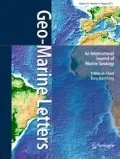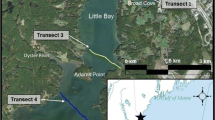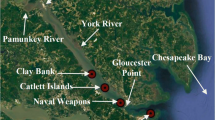Abstract
The expendable bottom penetrometer (XBP), a free-falling probe which can be deployed by a single person, is commonly used to rapidly classify seafloor sediment strength as hard, medium or soft. Assessments of deceleration-depth profiles of soft sediments (maximum deceleration smaller than 20 g) suggest that a finer subdivision of this class is possible. Thus, XBP datasets were recorded during two cruises aboard the R/V Planet in 2003 and 2006 in four study areas in the western Baltic Sea. The profiles can be distinguished in terms of gradient and curve progression. Comparing these data with descriptions of gravity cores taken at the same localities during the research cruises reveals a typical profile for western Baltic Sea mud, and distinct profiles for sediments containing localized inhomogeneities such as gravel, plant fragments, layers of sand or silt, and shell fragments. This good agreement between deceleration and sediment core information means that, once calibrated, XBPs can be used for a quick and suitably precise characterization of seabed sediments for research or engineering purposes. Notably, existing models to predict geotechnical properties such as shear strength and bearing capacity still show the disadvantage of involving excessively broad assumptions or estimates based on the bearing capacity factor or strain rate multiplier.
Similar content being viewed by others
References
Abelev AV, Valent PJ (2005) Utilization of XBP in predicting mine impact burial. Rep NRL/MR/7400-05-88780, Naval Research Lab, Stennis Space Centre
Aubeny CP (2005) Mine burial in cohesive sediments: undrained shear strength characterization. Rep Texas A&M University, TX
Aubeny CP, Shi H (2006) Interpretation of impact penetration measurements in soft clays. J Geotech Geoenviron Eng 132(6):770–777
Seifert A, Stegmann S, Mörz T, Lange M, Wever T, Kopf A (2008) In situ pore-pressure evolution during dynamic CPT measurements in soft sediments of the western Baltic Sea. Geo-Mar Lett (in press) doi:10.1007/s00367-008-0102-x
Shi H (2005) Numerical simulations and predictive models of undrained penetration in soft soils. Dissertation, Office of Graduate Studies of Texas A&M University, TX
Stoll RD, Akal T (1999) XBP—tool for rapid assessment of seabed sediment properties. Sea Technol 37:47–51
Stoll RD, Akal T (2001) XBP, an expendable bottom probe for evaluating geoacoustic and geotechnical properties of the sea floor. User’s manual, Version 1.2
Stoll RD, Sun YF, Bitte I (2004) Measuring sea bed properties using static and dynamic penetrometers. Rep Lamont-Doherty Earth Observatory of Columbia University, NY
Author information
Authors and Affiliations
Corresponding author
Rights and permissions
About this article
Cite this article
Stark, N., Wever, T.F. Unraveling subtle details of expendable bottom penetrometer (XBP) deceleration profiles. Geo-Mar Lett 29, 39–45 (2009). https://doi.org/10.1007/s00367-008-0119-1
Received:
Accepted:
Published:
Issue Date:
DOI: https://doi.org/10.1007/s00367-008-0119-1




